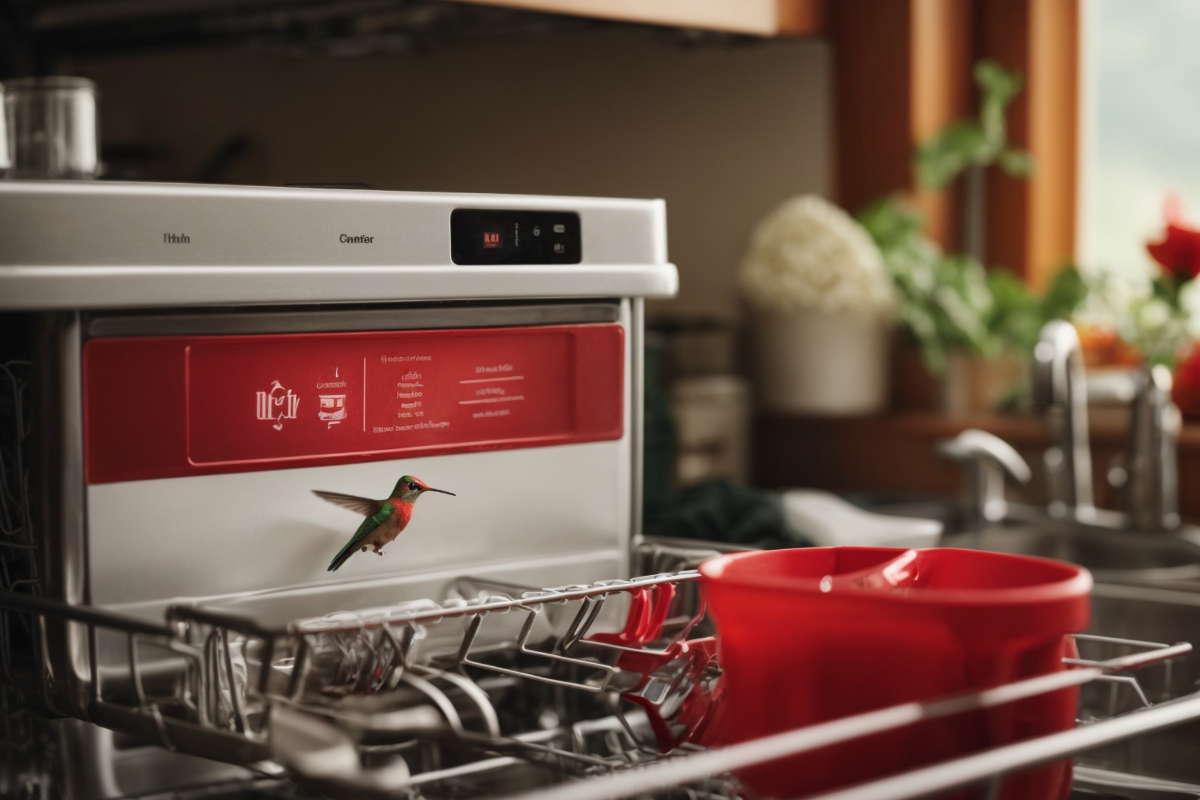As a fan of hummingbirds, our primary goal is to keep these beautiful birds safe while feeding in our garden. And one of the best ways to keep them safe is by keeping their feeders sparkling clean.
But when it’s time to clean the feeder, you may be wondering – can I just pop my hummingbird feeder in the dishwasher or not?
This is a great question; however, the answer depends on a few factors. In this blog post, we’ll explore if hummingbird feeders can be washed in the dishwasher.
I’ll also share the best ways to clean them and offer tips for keeping your feeders clean.
So, sit back and get ready to learn how to become an expert at cleaning your hummingbird feeder.
Can You Wash Hummingbird Feeders In The Dishwasher?
Yes, hummingbird feeders made of dishwasher-safe materials like glass or some plastics can be washed in the dishwasher. But, it’s essential to refer to the manufacturer’s guidelines. Some feeders can’t handle the dishwasher’s heat and detergents, so they need to be washed by hand.
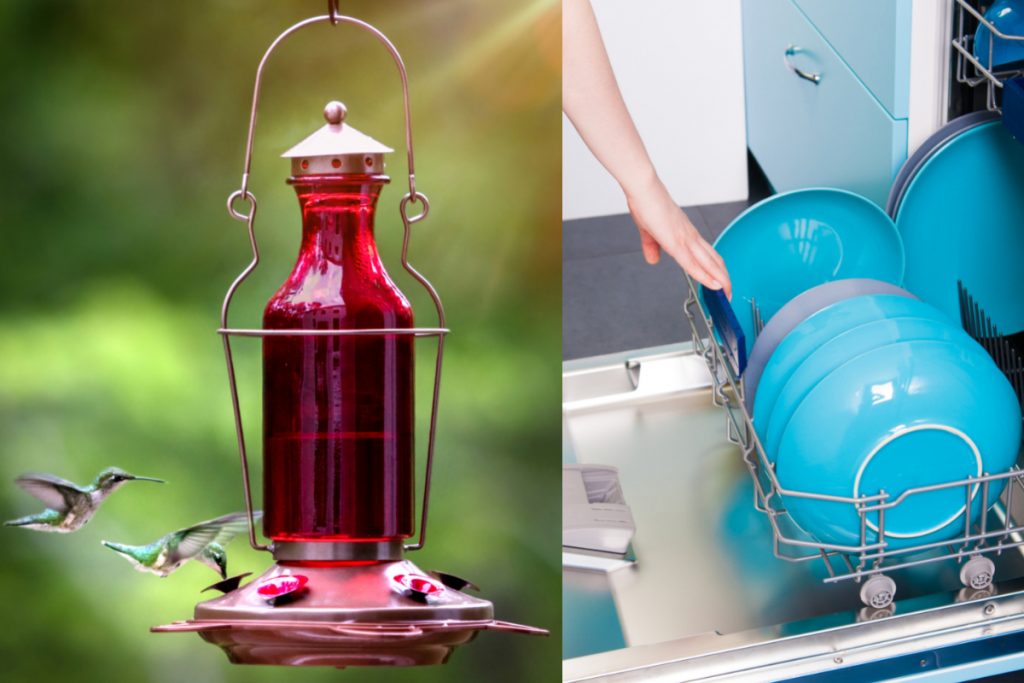
Tips
- Checking Packaging and Labels for Cleaning Instructions: Always consult the packaging or labels that come with your hummingbird feeder for cleaning instructions. Manufacturers often provide specific guidelines on whether their products are dishwasher safe.
- Consulting Manufacturer’s Websites: If you cannot find cleaning instructions on the packaging or labels, check the manufacturer’s website for more information. Many companies provide detailed cleaning and maintenance instructions on their websites.
By following the tips mentioned above, you can be sure you are correctly taking care of your bird feeder.
- Can You Wash Hummingbird Feeders In The Dishwasher?
- Why Proper Cleaning Matters
- Importance of Hummingbird Feeders
- Factors Affecting Dishwasher Safety
- Dishwasher-Safe Hummingbird Feeders
- Hand-Washing Hummingbird Feeders
- Tips for Maintaining Hummingbird Feeder Hygiene
- Natural Cleaning Solutions
- Final Thoughts
- FAQs – Are Hummingbird Feeders Dishwasher Safe?
- Q: How often should I clean my hummingbird feeder with hot water?
- Q: How do I clean the feeding ports of my hummingbird feeder?
- Q: Is a bottle brush a suitable cleaning tool for hummingbird feeders?
- Q: How do I keep my hummingbird feeders clean and the nectar fresh?
- Q: What are the consequences of using a dirty hummingbird feeder?
- Q: How many ounces of nectar should I provide in my hummingbird feeder?
- Q: Can I clean my hummingbird feeder using warm water and mild detergent?
- Q: What water solution should I use to rinse my hummingbird feeder after cleaning?
- Q: How can I keep my hummingbird feeder clean without spending too much time on feeder maintenance?
- Q: Are sugar water feeders better than pre-made nectars for hummingbirds?
- Q: How do I dispose of leftover nectar when cleaning my hummingbird feeder?
- Q: Can I use a vinegar solution as a cleaning method for my hummingbird feeder?
- Q: How many cups of water should I use when cleaning my hummingbird feeder with boiling water?
- Q: How do I clean hard-to-reach places in my hummingbird feeder?
- Q: How do I know when it's time to replace the nectar in my hummingbird feeder?
- Q: Should I use cold water or warm water to make fresh sugar water for my hummingbird feeder?
- Q: What can I do to prevent mold growth in my hummingbird feeder?
- Q: How should I clean feeding reservoirs in my hummingbird feeder?
- Useful Links:
Related posts to read:
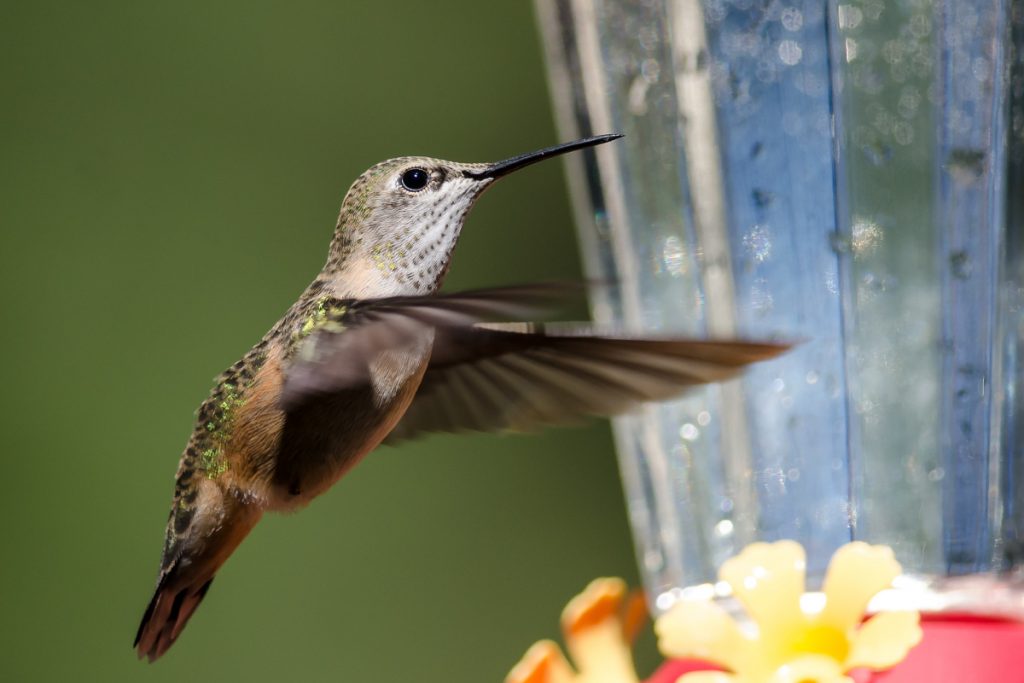
Why Proper Cleaning Matters
Keeping your hummingbird feeders sparkling clean is about more than just aesthetics. It helps:
- Prevent dangerous mold and bacteria from accumulating. This can make the birds sick.
- Remove insect eggs and larvae. Nobody wants bug-filled nectar!
- Maintain the feeder’s functionality. Grime can impede moving parts.
- Extend the feeder’s lifespan. Cleaning prevents deterioration.
So, while scrubbing feeders might feel tedious, just remember – you’re helping create a healthy and safe environment for your tiny, buzzing visitors!
Benefits of Using Dishwasher-Safe Feeders
- Ease of Cleaning: Dishwasher-safe feeders are simple to clean, requiring little effort on your part.
- Time-saving: Dishwasher-safe feeders can be cleaned quickly and efficiently, saving you time and effort.
- Thorough Cleaning and Sterilization: Dishwashers use high heat to clean and sterilise, removing grime, mold, and bacteria. This creates a hygienic feeding environment for hummingbirds.
Importance of Hummingbird Feeders
Hummingbird feeders play a crucial role in providing a consistent source of artificial nectar for these tiny, high-energy birds.
As hummingbirds use up a lot of energy, the nectar helps them stay active and strong. By having a feeder, you are helping these little birds get a good meal and sustain their energy levels.
Factors Affecting Dishwasher Safety
Materials Used in Hummingbird Feeders
- Glass: Glass feeders are often dishwasher safe, as they can withstand high temperatures without damage. However, certain decorative elements or painted designs may not be suitable for the dishwasher.
- Plastic: Some plastics are dishwasher safe, while others may warp or crack under high heat. Always check the manufacturer’s recommendations to determine if a plastic feeder is safe for dishwasher use.
- Metal: Metal components, such as feeder bases or perches, may not be dishwasher safe. Exposure to water and detergents can cause rust or corrosion. It is best to hand-wash these parts to prevent damage.
Components and Assembly of Hummingbird Feeders
Feeders with Removable Parts: Some hummingbird feeders can be disassembled, making it easier to clean each part individually. If the parts are made of dishwasher-safe materials, they can be cleaned in the dishwasher.
All-in-one Feeders: These feeders do not have removable parts and may be more challenging to clean thoroughly in a dishwasher. Hand-washing is often the best option for these types of feeders.
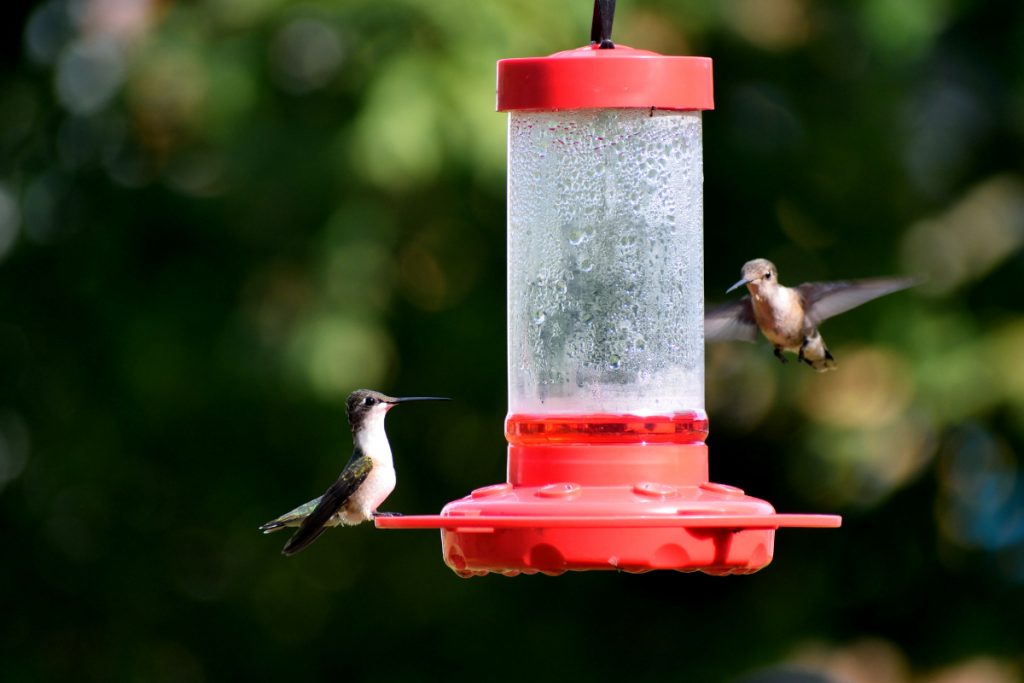
Dishwasher-Safe Hummingbird Feeders
Identifying Dishwasher-Safe Materials
Heat-Resistant Glass: Dishwasher-safe glass feeders are made from heat-resistant materials, such as borosilicate glass. These feeders can be cleaned in the dishwasher without damage.
Dishwasher-Safe Plastics: Some plastics, like BPA-free polypropylene, can safely withstand dishwasher use. Check the manufacturer’s recommendations to ensure that your plastic feeder is dishwasher-safe.
Hand-Washing Hummingbird Feeders
If your feeder isn’t dishwasher safe, don’t worry; hand-washing works great too. Here are some tips:
- Supplies: Use warm water mixed with mild, eco-friendly dish soap. Grab a soft-bristled bottle brush to get into spouts and natural sponges for other surfaces.
- Scrub: Gently scrub away dirt, nectar residue, and grime from all parts. Take extra time on grooves and crevices where the gunk likes to hide.
- Rinse: Thoroughly rinse with clean water to remove any lingering soap. This prevents residue from contaminating the nectar.
- Air Dry: Allow all parts to completely air dry before reassembling. Trapped moisture breeds bacteria.
I like to hand-wash my feeders about twice a week or whenever they look dirty. More frequent cleaning is ideal in hotter climates where mold thrives.
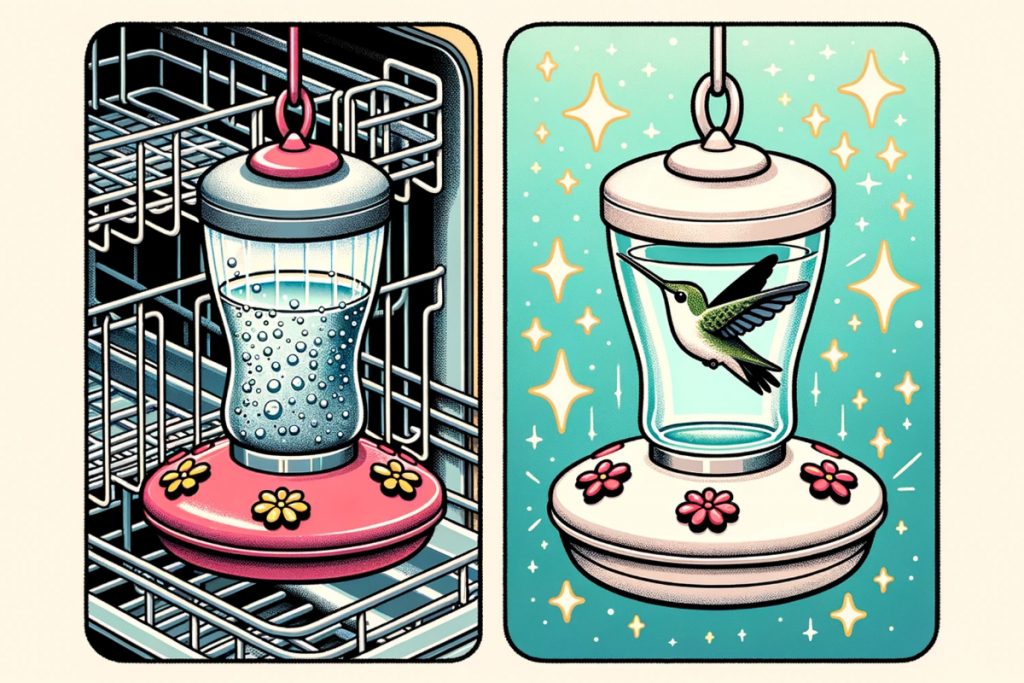
Tips for Maintaining Hummingbird Feeder Hygiene
To keep your feeders fresh and healthy between washes:
- Empty and refill nectar every few days, more often in summer. Stale nectar ferments.
- Check for signs of mold, larvae, ants, etc. and wash immediately if found.
- Consider using a mix of 1 part vinegar and 3 parts water, which can be used for periodic deep cleaning. Rinse very thoroughly after.
- Move feeder placement around to prevent buildup in one area.
With some basic care, your feeders will stay clean and invite hummingbirds all season long!
Natural Cleaning Solutions
For an extra boost of cleaning power, try these all-natural solutions:
- Lemon Juice: Contains citric acid that breaks down grime. Squeeze fresh lemon juice into your feeder, let it sit for 15 minutes, then scrub and rinse.
- Vinegar: Although I’ve just suggested this in the previous section. However, vinegar can’t be ignored when discussing safe cleaning solutions for hummingbird feeders. The acidity in vinegar helps dissolve gunk and kills bacteria. As I said before, combine 1 part vinegar with 3 parts water. Rinse well after soaking.
- Baking Soda: This creates a mild abrasive solution to scour away messes. Make a paste with water and use a soft brush to gently scrub.
Adding these natural ingredients to your cleaning routine helps remove stubborn buildup without harsh chemicals. The hummingbirds will thank you!
Final Thoughts
I hope you now feel equipped to keep your feeders clean, whether by dishwasher, hand-washing, or natural solutions like vinegar. Remember, proper cleaning allows hummingbirds to thrive.
Seeing these amazing birds hover at your hygienic feeder is magical. As a hummingbird fan, let’s savour every shimmering moment. While scrubbing may seem tedious, remember – each effort we put in helps hummingbirds to feed safely.
What do you think? Are cleaner feeders key to happier hummingbirds? I’d love to hear your thoughts! Thanks for reading.
FAQs – Are Hummingbird Feeders Dishwasher Safe?
Q: How often should I clean my hummingbird feeder with hot water?
A: Clean your hummingbird feeder at least once a week using hot water or more frequently in hot weather or if you notice signs of mould or insect infestation.
Q: How do I clean the feeding ports of my hummingbird feeder?
A: Use a small brush or a pipe cleaner to gently scrub the feeding ports, removing any dirt or residue. Rinse them thoroughly with water afterwards.
Q: Is a bottle brush a suitable cleaning tool for hummingbird feeders?
A: Yes, a bottle brush is an excellent cleaning tool for reaching the inside of bottle feeders and other hard-to-reach places.
Q: How do I keep my hummingbird feeders clean and the nectar fresh?
A: Clean feeders regularly and replace the nectar every few days, or more often in hot summer weather, to keep the nectar fresh and prevent bacterial growth.
Q: What are the consequences of using a dirty hummingbird feeder?
A: A dirty feeder can promote the growth of mould, bacteria, and other harmful substances, potentially causing illness or even death in hummingbirds.
Q: How many ounces of nectar should I provide in my hummingbird feeder?
A: The amount of nectar needed varies depending on the feeder size and number of visiting hummingbirds. Start with a few ounces of nectar and adjust the quantity as needed based on consumption.
Q: Can I clean my hummingbird feeder using warm water and mild detergent?
A: Yes, warm water and a mild detergent are effective in cleaning hummingbird feeders. Be sure to rinse the feeder thoroughly to remove any soap residue before refilling it with nectar.
Q: What water solution should I use to rinse my hummingbird feeder after cleaning?
A: After cleaning your feeder, rinse it thoroughly using warm or cold water to remove any soap or cleaning solution residue.
Q: How can I keep my hummingbird feeder clean without spending too much time on feeder maintenance?
A: Choose a feeder with a simple design and dishwasher-safe materials for convenient cleaning. Establish a regular cleaning schedule and replace nectar frequently to prevent spoiled food and mould growth.
Q: Are sugar water feeders better than pre-made nectars for hummingbirds?
A: Sugar water feeders offer a simple and cost-effective solution for providing hummingbirds with the energy they need. Pre-made nectars can be convenient but may contain additives that are unnecessary or potentially harmful to hummingbirds.
Q: How do I dispose of leftover nectar when cleaning my hummingbird feeder?
A: Pour leftover nectar down the sink or into a compost bin, and avoid reusing it, as it can become contaminated and spoil quickly.
Q: Can I use a vinegar solution as a cleaning method for my hummingbird feeder?
A: Yes, a vinegar solution can be an effective and natural cleaning method for hummingbird feeders. Mix one part white vinegar with four parts water, and rinse the feeder thoroughly afterwards to remove any vinegar residue.
Q: How many cups of water should I use when cleaning my hummingbird feeder with boiling water?
A: Use enough boiling water to fill and submerge the entire feeder, ensuring all parts are exposed to the high temperature, which helps to kill bacteria and remove grime.
Q: How do I clean hard-to-reach places in my hummingbird feeder?
A: Use a bottle brush, pipe cleaner, or other narrow cleaning tools to reach and clean hard-to-reach places in your feeder.
Q: How do I know when it’s time to replace the nectar in my hummingbird feeder?
A: Replace the nectar every few days or when you notice cloudy water or signs of spoilage. In hot weather, replace the nectar more frequently, as it can spoil quickly.
Q: Should I use cold water or warm water to make fresh sugar water for my hummingbird feeder?
A: You can use either cold or warm water to make fresh sugar water. However, if you use warm water, be sure to let the mixture cool to room temperature before filling the feeder.
Q: What can I do to prevent mold growth in my hummingbird feeder?
A: Prevent mold growth by cleaning your hummingbird feeder regularly, replacing nectar frequently, and choosing a feeder with a simple design that is easy to clean and maintain.
Q: How should I clean feeding reservoirs in my hummingbird feeder?
A: Disassemble the feeder and clean the feeding reservoirs with warm, soapy water or vinegar solution. Use a bottle brush or similar cleaning tool to reach all areas of the reservoirs. Rinse thoroughly with water before reassembling the feeder.
Useful Links:
Related Posts to Read:
- Do Hummingbirds Beaks Open When Feeding?
- The Mysteries of Hummingbird Flight.
- 6 Fascinating Facts About Hummingbird Sizes.
- Ruby-Throated Hummingbird Migration Map.
- Where Do Hummingbirds Go When It Rains?
- How Much Does A Hummingbird Eat Per Day?
References:
- About Hummingbird (Link).
- Greenewalt, C. H. (1960). Hummingbirds. New York: Doubleday. Google Scholar.
- Carey C. The impacts of climate change on the annual cycles of birds. Philos Trans R Soc Lond B Biol Sci. 2009 Nov 27; 364(1534):3321-30. doi: 10.1098/rstb.2009.0182. PMID: 19833644; PMCID: PMC2781852.
- Rico-Guevara A, Rubega MA, Hurme KJ, Dudley R. Shifting Paradigms in the Mechanics of Nectar Extraction and Hummingbird Bill Morphology. Integr Org Biol. 2019 Jan 2;1(1):oby006. doi: 10.1093/iob/oby006. PMID: 33791513; PMCID: PMC7671138.
- Tyrrell LP, Goller B, Moore BA, Altshuler DL, Fernández-Juricic E. The Orientation of Visual Space from the Perspective of Hummingbirds. Front Neurosci. 2018 Jan 30;12:16. doi: 10.3389/fnins.2018.00016. PMID: 29440985; PMCID: PMC5797624.
- Hummingbirds Sighting (Journey North Map).
- About Hummingbird’s Characteristics.
